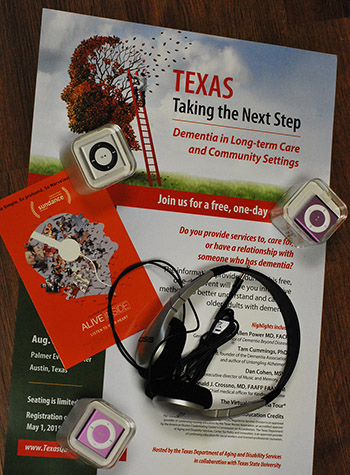Nursing students help mend memory with music
 Lamar University nursing students are helping implement the innovative Music and Memory project to enhance the quality of life of resident dementia patients through music. The work is part of a Texas Department of Aging and Disability Services (DADS) grant to College Street Health Center in Beaumont, one of only 32 nursing homes in the state in the program.
Lamar University nursing students are helping implement the innovative Music and Memory project to enhance the quality of life of resident dementia patients through music. The work is part of a Texas Department of Aging and Disability Services (DADS) grant to College Street Health Center in Beaumont, one of only 32 nursing homes in the state in the program.
“This was the only facility awarded the grant in this area,” Elizabeth Long, nurse practitioner, assistant professor of nursing at Lamar University and program champion said. “As part of a grant, the state of Texas gave each home 15 iPods, some ‘music money’ to load the iPods with songs, and paid for the staff to be trained in Music and Memory.”
The broader Music and Memory project trains family members, long-term care staff, and elder care professionals how to reconnect those with dementia to their surroundings and loved ones via personalized playlists on digital audio devices like iPods.
Long had previously worked at the facility before coming back to implement the program. She and students from the Lamar University Texas Nursing Student Association (LUTNSA) have partnered for the project.
“LUTNSA was asked to become involved with the Music Memory Project when Dr. Long contacted our advisor, Mrs. White,” LUTNSA treasurer Danielle Brackin said. “The other officers and I met with Dr. Long, and she presented the project to us. We were all immediately on board and excited about being a part of this amazing project.”
The 15 nursing students in the association participating in the project will help residents diagnosed with dementia build their personal playlists and turn in weekly journals detailing their experiences and the reactions of the residents.
“As nursing students, we have spent time in long-term care facilities, and the thought of being able to play a part in helping these individuals is more than gratifying,” Brackin said. “By visiting the residents every week and providing music that takes them back to days when life was more stimulating, we are hoping to impact their lives in a positive way.”
Music and Memory is based on the belief that a link exists between dementia sufferers’ favorite songs and forgotten autobiographical memories. Music-evoked autobiographical memories, or MEAMS, are often especially vivid or detailed due to our brains’ partiality for sounds. Basically, when things in one’s life happen to music or have a musical association, they are often more easily remembered.
Because of this, playlists are meant to reflect songs the patients would have known well or had an association with in order to recover memories related to the music. A friend of a resident, for example, told the home that he had often listened to Michael Jackson, Marvin Gaye and surprisingly, R. Kelly before the onset of dementia.
“I just think it’s so funny that he loved R. Kelly,” said Carrie Castloo, director of nurses at the College Street Health Center.
But that’s the unique part of the project. Some patients are more likely to remember Bing Crosby, others big band hits, and others yet, R. Kelly.
"We’re just starting the project. So we really won’t know for a few more weeks how the playlists themselves will affect the residents," Long said. "However, even without music, just having that additional care and interaction has made them smile.”
Long says too that the residents especially look forward to the students coming to the home, and likewise the students love to interact with them.
“My favorite part of the project so far was the day I met my resident,” Brackin said. “He was not in a very cheerful mood when I arrived, but in just the little amount of time I was there and started talking about music, he began to perk up. I cannot wait for my visit when I actually give him the iPod full of his favorite music. I believe that it will be an amazing experience, and he will greatly benefit from this project.”
LUTNSA has plans to hold an iPod drive later this year so that they may expand the project to other long-term care facilities and residents.
“In using music to spark memories of the residents’ past, we are hoping that instead of just living life day by day, they will begin to enjoy and even look forward to every day,” Brackin said.


